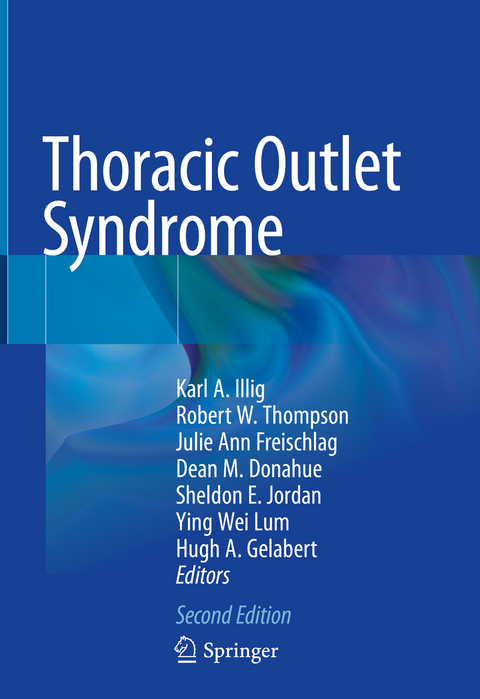
Thoracic Outlet Syndrome
Springer International Publishing (Verlag)
978-3-030-55072-1 (ISBN)
This extensively revised edition is an essential reference for physicians involved in the diagnosis, referral and treatment of the thoracic outlet syndrome (TOS). TOS is made up of a constellation of problems resulting from pathology at the thoracic outlet in the neck. Busy specialty practice sees multiple affected patients in every clinic, but TOS can often be difficult to diagnosis.
Thoracic Outlet Syndrome explores all possible ancillary care issues surrounding this complex condition, including rehabilitation, disability, natural history and medicolegal issues, and aims to stimulate research, discussion and a sense of community between professionals involved in this area. Vascular and thoracic surgeons, neurosurgeons, neurologists, psychiatrists and psychologists, physical therapists, occupational medicine specialists and pain specialists will find this book a must read for successful treatment, referral and diagnosis of TOS in clinical practice.
Dr. Illig relocated to the Dialysis Access Institute in Orangeburg, SC, the busiest multidisciplinary dialysis access center in the country, in 2018. Formerly Chief of Vascular Surgery at the University of Rochester and the University of South Florida, Dr. Illig has been practicing vascular surgery for 32 years. Involved in all aspects of Thoracic Outlet Syndrome, his major interests in this area include venous outflow stenosis in patients with arteriovenous access, recurrent neurogenic TOS, and education on this topic as a whole; he is particularly proud of his contributions (along with Hugh Gelabert) to the TOS Centre of Excellence in Great Britain. He is past president of the Vascular and Endovascular Surgical Society, a former member of the American Board of Surgery/Vascular Surgery Board, and an Academic Fellow of the Society for Vascular Surgery. Robert W. Thompson, MD is the Director of the Washington University Center for Thoracic Outlet Syndrome at Barnes-Jewish Hospital in St. Louis, MO. Dr. Thompson is an experienced research investigator who has studied the basic science pathobiology of abdominal aortic aneurysms, translational research on vascular disease, and clinical outcomes research on thoracic outlet syndromes. His clinical program is focused on all forms of thoracic outlet syndrome and upper extremity neurovascular compression disorders. The surgical management of patients with TOS is an area for which he has acquired an unusually rich experience and for which his expertise is widely sought. In building a nationally recognized referral center for patients with TOS at Washington University, Dr. Thompson has worked to develop a highly knowledgeable staff and an effective multidisciplinary collaborative team, which includes experts in physical therapy and rehabilitation, anesthesia and pain management, diagnostic and interventional radiology, and other related specialties. Julie A. Freischlag, MD is the Chief Executive Officer and Dean of Wake Forest Baptist Medical Center that includes Wake Forest Baptist Health, a growing, multi-hospital health system and physician network, the state-of-the-art and highly competitive Wake Forest School of Medicine, and Wake Forest Innovations, its technology transfer, commercialization enterprise. As CEO and Dean, she has the overall responsibility for the Medical Center's clinical, academic and innovation enterprises and its annual operating budget of $3.5B. In addition to serving in various national and international leadership roles, she mentors students, residents and young faculty and is a frequent speaker on topics ranging from her expertise in vascular diseases including thoracic outlet syndrome, teamwork and patient safety, leadership and work-life balance to women succeeding in health professions. She continues to care for and operate upon those patients with thoracic outlet syndrome and teach vascular residents and fellows to do the same. Freischlag has dedicated her career to serving as a role model for her students, a respected colleague across health professions, a strong community leader and a national voice for improving health and health care. Dean M. Donahue, MD, is the Director of the Thoracic Outlet Syndrome Program in the Division of Thoracic Surgery at Massachusetts General Hospital. He also serves at the thoracic surgery consultant for the New England Patriots, the Boston Bruins and the Boston Red Sox, as well as numerous collegiate sports teams. Dr. Sheldon Jordan has published original research in behavior modification of autistic and developmentally disabled children at the Kennedy Institute at Johns Hopkins Hospital and developed programs for schizophrenic and depressed patients at the Sheppard Pratt Institute. Dr. Jordan is recognized as a top neurologist by Best Doctors in America, Who's Who, Global Edition, and Super Doctors. His philosophy is to liste
A Brief History of the Thoracic Outlet Compression Syndromes.- Embryology of the Thoracic Outlet.- Evolutionary and developmental issues of cervical ribs/ Evolutionary issues of cervical ribs.- Anatomy of the thoracic outlet and related structures.- TOC: Clinical incidence and Scope of the Problem.- Pathology and Pathophysiology of NTOS.- NTOS for the Primary Care Team: When to Consider the Diagnosis?.- Diagnosis Of Neurogenic Thoracic Outlet Syndrome:2016 Consensus Guidelines And Other Strategies.- Differential diagnosis in Patients with possible NTOS.- Increasing objectivity in the diagnosis of NTOS: The East-meter.- A closer look at QuickDASH and CBSQ: what do they tell us?.- Scalene Test Blocks in patients with possible Neurogenic TOS.- Electrophysiological Assessment and Nerve Function in NTOS.- Pectoralis Minor Syndrome.- Double Crush Syndrome.- Unusual Nerve Entrapments and Neuropathic Syndromes of the Neck and Shoulder.- Cross-sectional imaging in thoracic outlet syndrome.-Ergonomic, Postural Issues, and Repetitive Stress Issues in NTOS.- Psychiatric and psychologic issues in NTOS.- Pathways Of Care And Treatment Options For Patients With Neurogenic Tos.- Physical Therapy as Primary Treatment for Neurogenic TOS.- Chiropractic and Nontraditional Treatment of NTOS.- Anesthesia For Thoracic Outlet Decompression.- Regional anesthesia for thoracic outlet decompression .- Surgical Techniques: Operative Decompression Using the Transaxillary Approach for NTOS'.- Surgical Techniques: Operative Decompression Using The Supraclavicular Approach For Neurogenic Thoracic Outlet Syndrome.- Surgical Techniques: Operative Decompression Using Thoracoscopic Approach for Neurogenic Thoracic Outlet Syndrome.- Surgical Techniques: Pectoralis Minor Tenotomy for NTOS.- Surgical Techniques: Dorsal Cervico-Thoracic Sympathectomy.- Botulinim Toxin Injection and Advanced Interventional Techniques for NTOS and Cervical Brachial Syndrome.- Ntos In The Competitive Athlete.- Neurogenic TOS in Children.- Recurrent and Residual Neurogenic Thoracic Outlet Syndrome.- Controversies in NTOS: What testing is needed to establish the diagnosis?.- Botulinum Toxin Injections for Neurogenic Thoracic Outlet Syndrome.- What do the results of conservative therapy tell us about the need for surgery:Lack of Improvement means surgery is indicated.- Point/Counterpoint: What does the result of conservative therapy tell us about the need for surgery? Improvement means surgery is indicated.- Controversies in NTOS: Transaxillary or Supraclavicular First Rib Resection in NTOS? Arguments Pro and Con the Transaxillary approach In Favor of Transaxillary First Rib resection.- Point/Counterpoint: Supraclavicular Decompression Is The Best Approach For Neurogenic Thoracic Outlet Syndrome.- Does the first rib always need to be removed?.- Controversies in NTOS: What is the evidence supporting brachial plexus neurolysis and wrapping.- Neurogenic Tos: Early Postoperative Care.-Perioperative Pain Management for Thoracic Outlet Syndrome Surgery.- Rehabilitation after First Rib Resection.- Outcomes After Treatment of NTOS.- Management of Nerve Dysfunction after First Rib Resection.- Management of Coexisting Factors Complicating NTOS.- Treatment for Thoracic Outlet Syndrome - A UK Perspective.- Neurogenic TOS in the United Kingdom: A Consultant Orthopaedic Physiotherapist's view.- Diagnosis and treatment of thoracic outlet syndrome in The Netherlands.-Research Directions in Neurogenic Thoracic Outlet Syndrome.- Anatomy and Pathophysiology of Venous Thoracic Outlet Syndrome.- Diagnosis of VTOS: 2016 Consensus guidelines.- Imaging in VTOS.- VTOS for the PCP- When to Consider the Diagnosis.- Hypercoagulable Conditions and VTOS.- VTOS in the Competitive Athlete.- Thoracic Outlet Syndrome in Hemodialysis Patients.- Differential Diagnosis, Decision-Making, and Pathways of Care: Acute Thrombosis and Non-thrombotic Positional compression.- Management Of Chronic VenousThoracic Outlet Syndrome.- Conservative (Non-Operative) Treatment of VTOS.- Thrombolysis and Balloon Venoplasty for Subclavian Vein Thrombosis.- Surgical Techniques: Operative Decompression Using the Transaxillary Approach for Venous Thoracic Outlet Syndrome.- Surgical Techniques: Operative Decompression Using the Infraclavicular Approach for VTOS with Intraoperative Venography.- Surgical Techniques: Operative Decompression Using The Paraclavicular Approach For Venous Thoracic Outlet Syndrome.- The Robotic Transthoracic Approach for Venous Thoracic Outlet Syndrome.- Medial Claviculectomy for VTOS.- Advanced Surgical Techniques in Venous Thoracic Outlet Syndrome.- Point/Counterpoint: Is Thrombolysis Always Required in patients with effort thrombosis? b) NO - it is not always indicated.- Management of Residual Stenosis after thrombolysis.- First Rib Resection is always needed after thrombolysis.- Controversies in VTOS: Is thrombolysis alone sufficient treatment for VTOS?: YES.- Controversies in venous thoracic outlet syndrome: timing of first rib resection after thrombolysis.- Controversies in VTOS: What Is the Best Approach for VTOS?.- Controversies in VTOS: What Is the Best Approach to the First Rib in VTOS?.- Point/Counterpoint: Paraclavicular Decompression Is The Best Approach For Venous Thoracic Outlet Syndrome.- Controversies in Venous Thoracic Outlet Syndrome: Is There a Role for Venous Stents?.- Venous Tos: Early Postoperative Care.- Controversies in VTOS: How Long Should Anticoagulation Be Used in VTOS?.- VTOS: Management of the contralateral side and asymptomatic compression.- Outcomes After Treatment of VTOS.- Assessment and treatment of recurrent Venous thoracic outlet syndrome.- Anatomy and Pathophysiology of ATOS.- Clinical Presentation and Patient Evaluation in ATOS.- ATOS Consensus Guidelines.- The axillary artery and humeral head in ATOS.- Quadrilateral Space Syndrome.- Arterial Thoracic Outlet Syndrome In The Competitive Athlete.- Decision-Making andPathways of Care for ATOS.- Surgical Techniques: Endovascular Intervention for Arterial Thoracic outlet Syndrome.- Axillosubclavian Artery Repair and Reconstruction.- Upper Extremity Fasciotomy After Arterial Embolization.- Quadrilateral Space Syndrome and Management of the Posterior Circumflex Humeral Artery.- Management Of Digital Emboli, Vasospasm, And Ischemia.- Outcomes After Treatment of Arterial Thoracic Outlet Syndrome.- Recurrent and residual ATOS.- Medicolegal Issues in TOS.- Disability and Workers' Compensation Issues in TOS.- Special Considerations in the Elite High Profile Athlete.- Combined and Secondary Forms of TOS.- TOS: The Perspective of the Patient.- Venous TOS: The Perspective of the Patient.- TOS, the Internet and Social Media .- Establishing a TOS-Focused Practice.
| Erscheinungsdatum | 27.01.2021 |
|---|---|
| Zusatzinfo | XVI, 915 p. 361 illus., 250 illus. in color. |
| Verlagsort | Cham |
| Sprache | englisch |
| Maße | 178 x 254 mm |
| Gewicht | 2265 g |
| Themenwelt | Medizinische Fachgebiete ► Innere Medizin ► Kardiologie / Angiologie |
| Schlagworte | Cervical Sympathectomy • Complex regional pain syndrome • Costoclavicular Junction Decompression • Double Crush Syndrome • First Rib Resection • Gilliatt-Sumner Hand • Pectoralis Minor Tenotomy • Thoracic outlet syndrome • Thoracic Surgery |
| ISBN-10 | 3-030-55072-9 / 3030550729 |
| ISBN-13 | 978-3-030-55072-1 / 9783030550721 |
| Zustand | Neuware |
| Informationen gemäß Produktsicherheitsverordnung (GPSR) | |
| Haben Sie eine Frage zum Produkt? |
aus dem Bereich


